
As public commentary ramps up about schools excluding students who display extreme behaviours, Perry Rush, President of the New Zealand Principals’ Federation has reiterated the views of the Federation.
“Let’s be clear,” he said. “School principals support the inclusion policy and believe every child has the right to an education for which they are best suited.”
“It becomes difficult, when schools are directed to enrol students with extreme behaviours when either the school is unsuitable or the support is inadequate,” he said.
Not every school is physically suitable to accommodate every child’s learning, a statement from the NZPF read. “Some young people, such as autistic children, often require a low sensory environment. A school that operates as a modern learning environment, with lots of glass walls and an open and busy learning environment, may not be suitable for such a young person, unless the frequency of their sensory overload was helped by being able to work in a low sensory room, if the school had such a room. Sensory overload for autistic children can lead to significant behaviour incidents and the evacuation of hundreds of students using the open and busy learning environment.”
“Sometimes the environment is simply unsuitable for a student with particular needs,” says Rush. “Other times the resource is insufficient or inadequate to meet a particular student’s needs,” he said.
“We must not assume that carefully matching the educational environment and support to the child’s needs is somehow less inclusive. One size does not fit all.”
“There are some excellent schools with suitable low sensory rooms, teachers trained in neurodiversity, and experienced Teacher Aides yet some of them have had to exclude a child because another child or staff member has been unexpectedly attacked and physically injured,” he said. “In one survey principals reported over 600 examples of physical violence including sexual assault, biting, spitting, hitting, knifing, stabbing and throwing objects which have harmed either a staff member or another student,” he said.
“What we want is a safe learning environment for all young people, and that might mean that sometimes a student accesses additional help, therapy or counselling outside of the classroom until they can be safely returned,” he said.
“What is clear to us is that we can end the practice of exclusions from school by improving the provision and resourcing for our most complex young people. We need to stop the damaging cycle of successive exclusions.”









